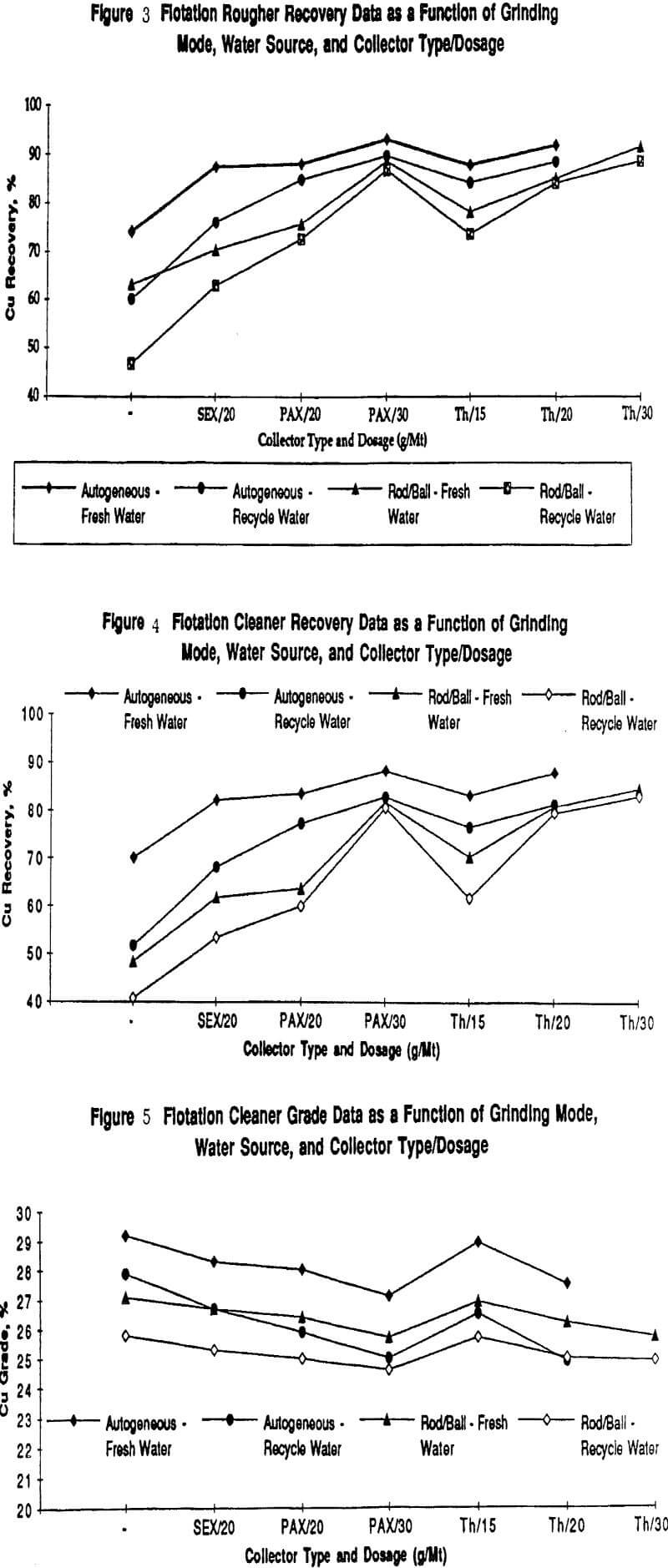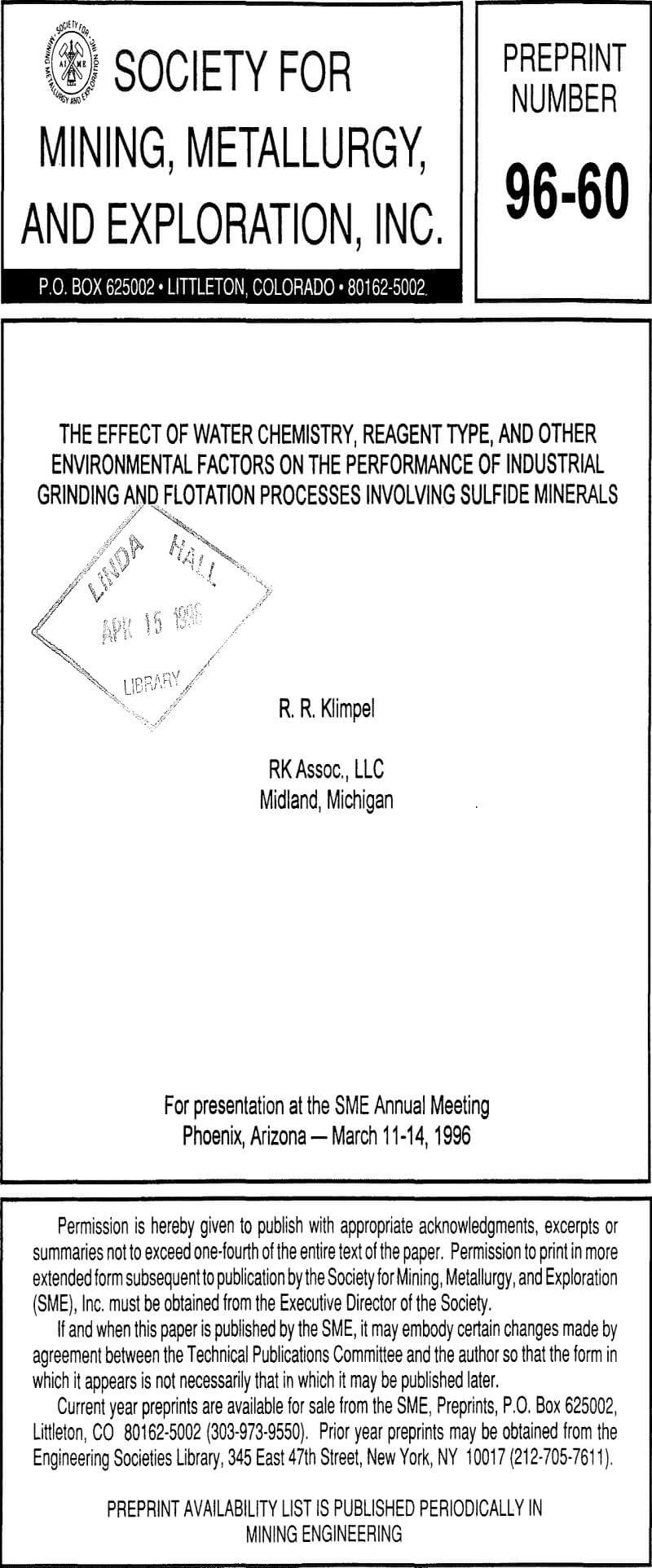In grinding, the use of steel media in a rod/ball mill circuit clearly diminishes the subsequent froth flotation performance over purely autogenous grinding. The use of recycle water in grinding also clearly diminishes the subsequent froth flotation performance associated with fresh tap water. Some of these flotation deficiencies are recoverable by using stronger collectors at higher dosages. On the positive side, a new collector chemistry concept based on using the inherent electrochemical transformations initiated by grinding is showing good promise at the plant scale. However, the impact of organics from water soluble collectors can be significant in reducing the pyrite selectivity possible with the electrochemical approach
The Influence of Steel Grinding Media Versus Autogeneous Grinding on the Efficiency of Sulfide Mineral Flotation: For several years, this author was involved with a flexible size reduction/classification/froth flotation pilot plant that possessed the capability of either an autogenous mill or a ball/rod mill combination. The mill sizes were selected so as to offer the potential of producing a fairly balanced throughput rate to size reduction (approximately ¾ Mt per hour) giving a similar one-point size distribution match of the feed to the flotation rougher bank. The associated flotation process consisted of six rougher mechanical cells followed by two cleaner mechanical cells. Many studies were conducted during this period including several related to the effect of size reduction mode on subsequent flotation efficiency. As reported in fundamental studies, Rajagopal and Iwasaki (1992), it became quite evident that at least some sulfide minerals did show a difference in flotation efficiency between the autogenous mill mode and the rod/ball mill combination.

The specific mineral system studied in some detail was a chalcopyrite/pyrite ore of 1.37% Cu and 9.82% pyrite. In all of the data to be reported in this paper, the one-point target grind was 15.0% +65 mesh U. S. (210 microns). The steel grinding media used were classified as forged carbon steel. The factors that were systemically varied included: water source (either tap water or recycled process tailings water) and collector type [either sodium ethyl xanthate (SEX), potassium amyl xanthate (PAX), or isopropyl ethyl thionocarbamate (Th)]. The recycled process water contained a significant number of various thiol salts as well as higher Ca++, Fe+++, and stray organic levels than the tap water. All collector reagents, the frother, and lime to a pH of 10.5 were added to a conditioning tank after grinding but before flotation. The frother used was DOWFROTH 250 with the dosage added at a one-to-one ratio to the collector dosage. All tests consisted of ten minute composite samples collected over a two hour steady-state period.
Figures 3, 4, and 5 show the flotation data collected for the various modes, collector types, and water sources. Inspection of these figures shows a number of significant and potentially useful industrial trends. To begin with, it is evident from comparing the autogenous data versus the rod/ball mill data at comparable water and collector conditions, that the flotation pulps prepared in the rod/ball mill circuit do demonstrate lower flotation rougher and cleaner recoveries as well as lower Cu concentrate grades. These figures also show a number of interesting trends that have a direct bearing on industrial flotation practice. Briefly stated these are:
- The natural or collectorless flotation characteristics of chalcopyrite are clearly influenced in a negative manner by going from autogenous to rod/ball mill grinding and also by using recycle water versus fresh water. The only test combination that significantly takes advantage of the natural flotation character of chalcopyrite is the autogenous grind using fresh water. It is also evident that this particular combination of autogenous plus fresh water gives rougher recoveries, cleaner recoveries, and cleaner grades that are clearly superior to the other three grinding mode/water source combinations tested regardless of the collector type and dosages involved. The other three combinations, while showing differences, are much more similar in performance than the autogenous/fresh water combination.
- Regardless of the grinding mode employed, the use of recycle water from the flotation process clearly has a negative impact on flotation with all of the collector types and dosages being used. It is also worthy to note, that the negative impact of using recycle water is more pronounced in magnitude on the autogenous grinding mode then with the rod/ball mill mode. This is especially true of the concentrate grade achievable with the limited cleaner capacity available as shown in ) Figure 5.
- The loss of performance experienced when departing from the optimal autogenous/fresh water combination is to some extent, overcome by operating in regions of higher collector dosage, regardless of collector type. For example, in Figures 3 and 4, there is little difference in the rougher and cleaner recoveries achievable with the other three grinding mode/water source combinations at a potassium amyl xanthate dosage of 30 g/Mt and a thionocarbamate dosage of 20 to 30 g/Mt. It is also important to point out, however, that the unique performance achieved with the autogenous/fresh water combination is not actually matched by any other combination of test conditions at the higher collector dosage operating conditions.
- The measured flotation performance due to differences in grinding mode and water source dominate the differences measured by changing collector type. Sodium ethyl xanthate is clearly not hydrophobic enough (not strong enough) to be competitive in this application except possibly with the autogenous/fresh water condition. The thionocarbamate gives a little better concentrate grade (better pyrite rejection) than the potassium amyl xanthate, but the differences are relatively small.

